On 31 December 2014 I launched a weather balloon! The weather observers do weather balloon (radiosonde) launches twice a day during the summer and once a day during winter here.
I went with Carol and Elin to the Mac Weather office, where the forecasters, observers, and Joey work. We asked the observer, Edward, if we could join him in the balloon launch and he was more than happy to have us along. They’ve said that doing the launches ends up becoming a chore rather than a fun experience, but for us newbies and weather nerds it’s awesome!
He gathered the string and instrumentation and we walked to the launch site called Sausage Point (there’s a fun story behind this name), which is across Winter Quarters Bay from Hut Point. It’s near the weather office, but we need to walk through the water treatment facility… Random yes, and smelly, but also nice and humid inside!
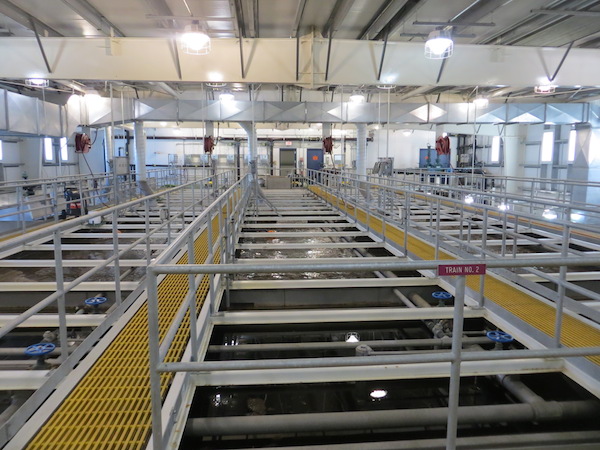 The water treatment facility We then come to a staging area where the balloons are kept and we can access the helium. Edward meticulously attached the balloon to the nozzle, started pumping the helium. While the balloon was getting bigger and bigger, he made final preparations such as cutting the string at proper length to tie the instruments to the balloon and making some calls, presumably to Mac Ops notifying them and any air traffic that a balloon will be launched soon.
 The instrumentation. All the data is gathered on this device!  The balloon, pre-inflation.
Finally the balloon was done inflating (took about 3 minutes) and Edward turned off the supply of helium. He tied the string real, real tight and handed me the now-connected instrument and balloon. At that point, all I really had to do was make sure the balloon didn’t hit anything as I exited the staging area to go outside and make sure I let go of it when I planned on letting it go!
 Edward (left) making final preparations before handing it all to me.
Of course, I posed for a couple photos (thanks to Elin for taking them) and then I let it go!
 Me and the weather balloon.  Goodbye balloon! 
As others have told me and I realized myself, it is odd letting go of instrumentation like that. It doesn’t feel right. But it is majestic when the balloon takes to the sky; a bright white orb sharply contrasted against the deep blue, with the instrumentation at the end of the string revolving rapidly, almost uncontrollably, below the balloon. Yes, I’m a weather balloon newbie indeed.
And as a bonus, we have the data from the launch available on our ftp site! You can find it here:
ftp://amrc.ssec.wisc.edu/pub/mcmurdo/radiosonde/2014/USAP.NZCM.UPPERAIR.14123112.dat
The data is in columns, and I think all the column labels are self-explanatory except U(), which is relative humidity, in percent.
Cheers!
Dave
Hello Everyone!
It has been a busy week here in Antarctica, which started with Christmas Dinner last Thursday. Here on base, we had the 25th and 26th off so we were able to enjoy Christmas dinner together on Christmas day. Technically, this was our second day off since getting to Antarctica and I think it was a much needed break for everyone. The dinner was delicious featuring prime rib, crab, a bunch of appetizers, and plenty of different types of desserts. We all went up for multiple plates of food!
 From left to right: Carol, Dave, Lee, and Elin After a nice 2 days off, we found out we were on the helicopter schedule to visit Ferrell for the morning of 27 December. I was so excited to go on my first station visit and go on a helicopter for the first time! Our flight time was at 9am, so we got ready to leave Crary a little after 8am. Then we went in the PAX terminal to weigh ourselves and all of cargo before the flight and put the cargo in one of the loading boxes.
Then we headed out to the helicopter, got our seatbelts clipped, and our helmets plugged into the radio. Soon enough we were off flying to Ferrell! We flew true east to the Ross Ice Shelf and it was my first time getting a really good view of all of the topography in the area! It was a beautiful view from the helicopter. As we were flying, we were able to communicate with the pilots to discuss if they were going to leave us at the site or come back in a couple of hour to pick us up. Since there were low level clouds over the ice sheet, it was decided that we shouldn’t be left there since it might be difficult to come back to the location later. Our goal was to try and finish in about an hour so the pilots wouldn’t get too behind schedule.
We got all of our cargo unloaded and we got right to work. Unfortunately, the weather was quite windy which made it a little more difficult. We tried to dig down to the batteries to retrieve them, but we decided that we weren’t going to have enough time to dig them out. We brought a power system with us, so we were able to connect it at ground level.
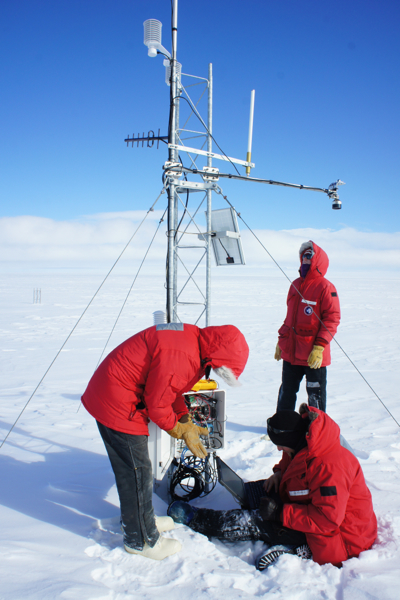 Working on Ferrell from left to right: Dave, Lee and Carol Then we raised the enclosure box about 3 feet up to make sure it doesn’t get buried over the next year, and dissembled the argos antenna. We completed all of our station measurements and then had to fiddle with checking the freewave transmission which only occurs every 30 minutes. After about an hour and a half we and the pilots decided that we should start getting ready to head back to McMurdo. We all climbed back in the helo to warm up a little before Lee could head back to reconnect at the right time to check the transmission. After a quick warm up, Lee went back out to the station to check but the helicopters had to start the engine so it was a little bit stressful. In the end we weren’t able to connect to check the transmission before we left, but in getting back to lab we learned that it had worked! Unfortunately, the station still doesn’t have a consistent data flow so we might head back to Ferrell later in the season to change the transmission to Iridium. Overall it was still a successful first visit!
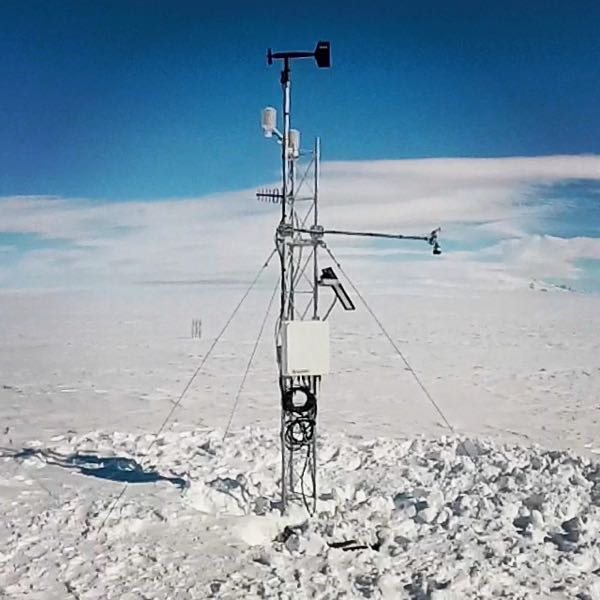 Ferrell AWS after 27 December visit The next day we were on the schedule again to head out to Laurie II! This site had not been visited in 8 years, so we all knew there was a high possibility that we weren’t going to be able to find it for multiple reasons 1.we knew it was going to be very buried by the snow and 2. we knew it is on a moving ice sheet, so the GPS locations were going to be incorrect. We got ready to fly out and we warned the pilots of the situation and just as we thought, it wasn’t obvious at first glance. Image flying in a helicopter and getting to a ice sheet where you can see for what seems like miles. I was thinking we have to be able to find this because it’s going to stick out since there’s nothing else out there….. literally nothing else. This was not the case. It ended up taking us 30 minutes of searching to finally find it 5km northeast of the GPS locations from 8 years ago. The helo tech found it and we were all so surprised and happy when he said over the radio that he spotted it. Then the pilots left us at the site for the next 7 hours 🙂
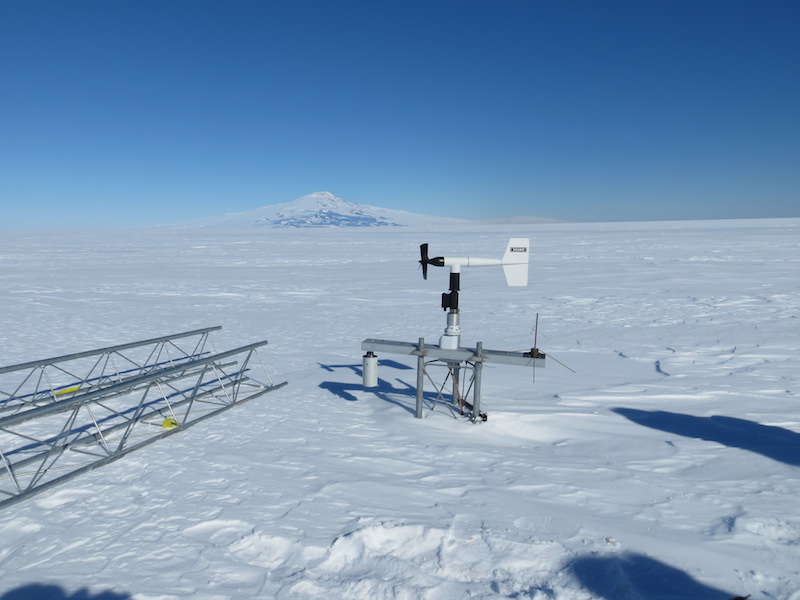 Laurie II about 2.5 feet tall Then we got to work digging! We needed to get to the bottom of the enclosure which ended up being about 5 or 6 feet below the snow surface. This took about 2 hours of digging and carefully using the ice pick to get to the cables and plugs.
 Digging down to the bottom of the enclosure from left to right: Elin, Lee, and Dave Then we did a full raise with 2 – 7 foot tower sections to make the tower about 16 feet above the surface. Once the tower sections were in place we all did some training climbing the tower and getting comfortable with the harnesses. Then it was time to move all of the instruments as high as we could. This way we don’t have to visit the sites quite as frequently because of snow accumulation. At this point it was definitely a team effort with 2 people on the tower and the other 2 getting tools and visuals for the people on the tower.
 Dave and Elin fixing the instrument boom to the top of tower section Then we wrapped up and taped the cables and started to refill in the pit we made. The whole raise took about 5.5 hours. Then we checked the transmission and it was working, so all was well. At this point we needed to get picked up, so we called helo operations and we had to wait around for another hour for a helo to come pick us up. In the mean time, we took some fun photos and played some baseball with ice balls and a shovel. Then we heard the helo coming and we all got down and prepared for about 30 seconds of the most intense winds I have ever experienced. Basically the helicopters land about 30 feet from where you are sitting, so it’s a huge wind gust right when they land (I have a really good video I will try and show later). Then we loaded the helo and after a long day we headed back to McMurdo.
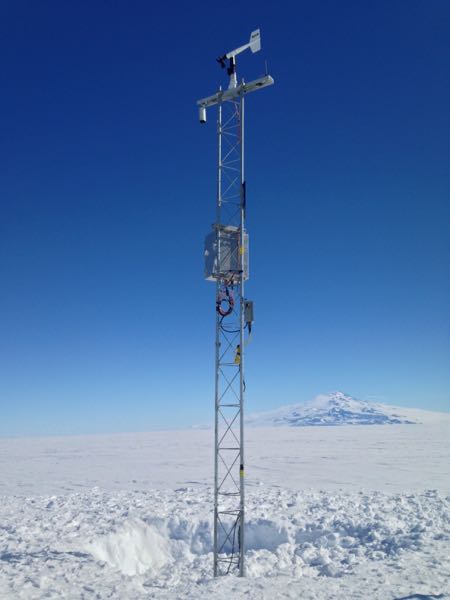 Laurie II after raise with Mount Terror in the background The next day we had the day off of flying, but 30 December we got to go on an unexpected visit in the middle of the afternoon. About 2:30pm we got a call from helo ops that we could try and head out to Minna Bluff, so we said we would be ready in 45 minutes. We quickly got all of our cargo together and one of our office mates was able to drive us down in the pickup truck with our power system. Then we got all of our cargo weighed and ready to get on the helo after a hectic 30 minutes of getting everything together. Then we got to Minna Bluff and it was my first time on the actual continent of Antarctica since McMurdo is on Ross Island and the other AWS are on the Ross Ice Shelf.
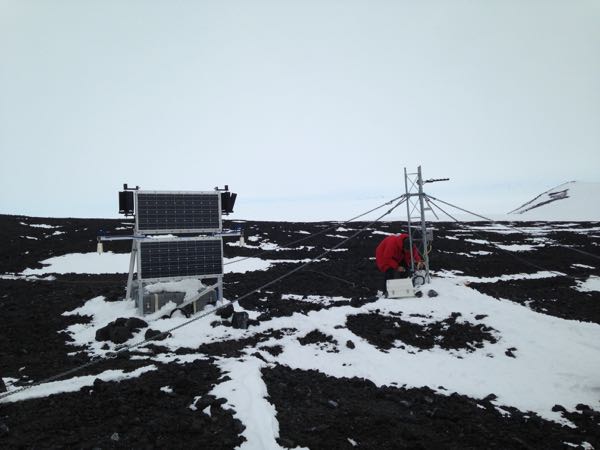 Minna Bluff AWS on the right I’m going to give you a quick history over the past year of Minna Bluff AWS. In August the station stopped transmitted unexpectedly. There was nothing we could do until we had planned to visit it in November. In November, we got an e-mail with pictures showing that the whole instrument boom had come off of the tower section. This must have occurred during a particularly intense storm with high winds speeds. During October, Minna Bluff often has a maximum wind speed of 40 m/s or 90 mph, so it’s not surprising for instruments to get damaged. Lee and Drew visited Minna Bluff mid November to recover the instruments and bring them back to the lab to test if they could be reused. Lee worked on testing the instruments and decided that we could bring them back to the site and reuse the high wind speed aerovanes. During this visit we were able to replace the instruments and change out the batteries for a new power system. This visit took just about an hour, so we were able to get back in time for dinner!
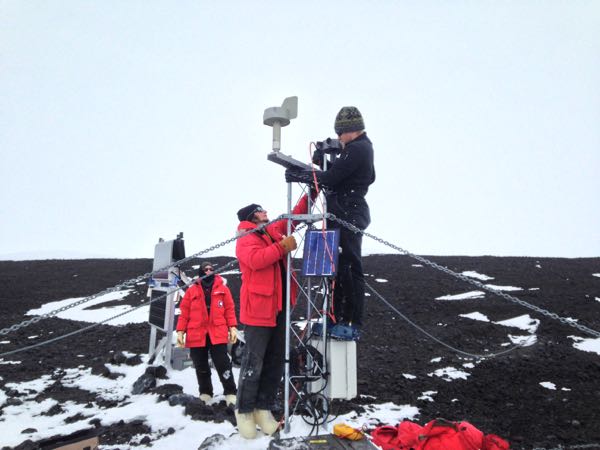 Fixing Minna Bluff from left to right: Elin, Dave, and Lee I think that’s it! At this point we are hoping to maybe get one more chance to take a flight to Marble Point and Cape Bird before Dave and I head to South Pole on 5 January. 13 sites have been visited out of list of 33, so we are doing well so far!
Here’s a video I made about traveling to Antarctica:
https://www.youtube.com/watch?v=gSBsl9fWbrQ
Happy New Year! More updates to come!
Carol
Hello Again!
Dave, Elin, and I have now been in Antarctica for a week! Unfortunately we haven’t been able to take any flights out to our sites in the past week due to cloudy skies and crowded scheduling for the helo flights.. We have been trying to fly to Ferrell or Laurie II since Monday, but it hasn’t worked out. In the mean time, we have been able to get a lot of stuff ready for our teams trips to WAIS (West Antarctic Ice Sheet) and South Pole. The main things we have been able to do is build power boxes and haul all of the parts of the AWS to the science cargo center.
First, we decided to build the power boxes. We got a truck and drove up to our orange shed to fill the truck with about 20 batteries that each weigh about 65 pounds. Then we brought them back to Crary lab to charge them up overnight.
 Truck full of batteries 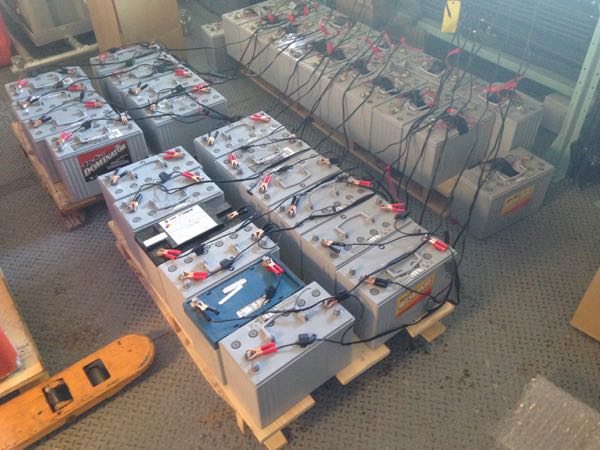 Charging all of the batteries before we pack them into the power boxes Once all of the batteries were charged we put them into power boxes which are large black pelican cases that are stuffed with foam. Then we cut out the foam and insert 2 batteries per box. Then we cover the batteries with another layer of foam, and then the solar panel goes on top. We probably made about 7 or 8 boxes each of them weighing 181 pounds!
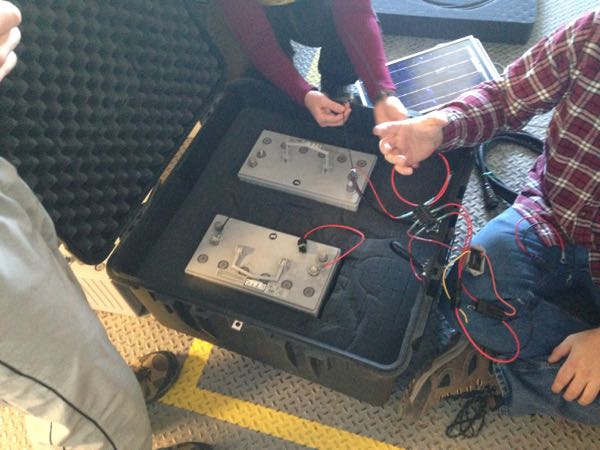 Power box with the solar panel in the upper right corner Then once those were made we went back to the orange shed to grab some other items like tower sections. We then checked to make sure we had all of the different stations that we needed and we drove all of the very heavy stuff to science cargo to get packed up for the flight to WAIS.
 Packing all of our 10 foot and 7 foot tower sections  All of our gear that’s ready to go out to WAIS, and those black bags are Elin and Lee’s sleep kits After everything was packed, weighed, and strapped down on the palates, we made sure to inventory all of our items with the correct projects numbers, locations, and weights.
Lee and Dave have been working on wiring for the new South Pole stations; Henry and Nico. Otherwise there’s not too much other stuff we need to do to prep for our trips. We are hoping we can take our first helo flight on Saturday!
 Setting up some of the instrumentation for Henry Otherwise, we have been able to participate in a weather balloon launch with Ang, go on a hikes to Hut Point and Observation Hill, and make a little video of Christmas cheer! Enjoy!
https://www.youtube.com/watch?v=srjKsE8WG2A&feature=youtu.be
 View of McMurdo from Observation Hill Merry Christmas!
Carol
Hi everyone! Dave has already introduced me, but I’m Carol Costanza and I’m a research intern at the Antarctic Meteorological Research Center. This is my first time to Antarctica, so this past week has been a whirlwind of new and awesome experiences!
I’m going to start off with getting issued our ECW (Extreme Cold Weather) gear in Christchurch, NZ on Monday, 15 December. We watched a couple of videos about issues including NSF policies, medical issues, and proper clothing. Then we proceeded to try on our clothing to make sure that it all fit properly.
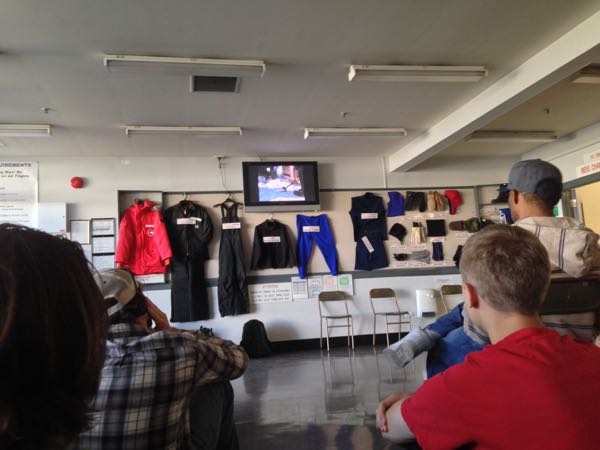 Watching training videos with the wall of ECW clothing in the background Some of the gear I got included a red parka, snow pants, bunny boots, goggles, gloves, mittens, glove liners, neck warms, a fleece jacket, fleece pants, and a balaclava. This clothing was then all stored at the CDC (Clothing Distribution Center) in orange bags until our flight to Antarctica. Then we were delayed for a day in New Zealand, but we did head back to the CDC two days later on Wednesday, 17 December for our flight down to the ice at 1pm.
Before the flight we had to change into our ECW gear and then weigh all of our gear. We had a fairly strict weight limit of 75 pounds of checked bags and 15 pounds for carry on. We checked in for our flight and then we watched some more training videos about the flight. We all had to check in for our flight early, so we had plenty of time to grab some food and play a couple of games of cribbage!
 Briefing room before our flight on the LC-130 Then we got ready to get on the plane! We took a short bus ride to the runway and we were given ear plugs and a lunch when we entered the plane. It was an 8 hour flight that was long and very loud. Here a couple of pictures of what it looked like on the inside.
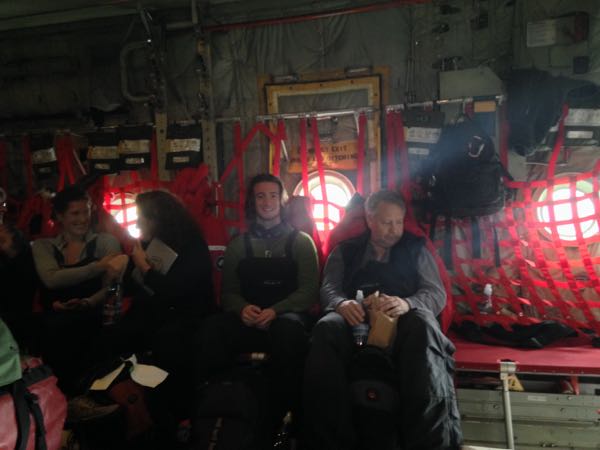 Dave sitting across from me on the LC-130  The seating was like this on both sides of the L-130 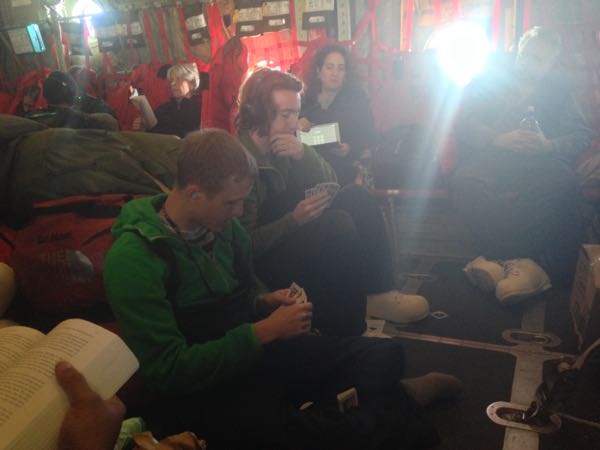 Dave and Joey playing cribbage on the plane 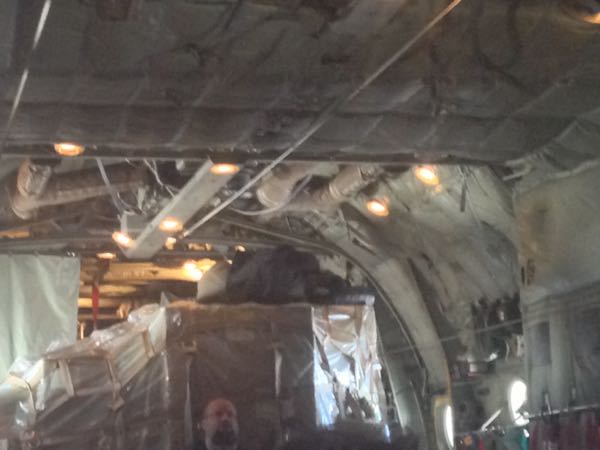 Air Force personnel sleeping on one of the palates in the back Then once we landed we took a Delta, a bus with HUGE wheels, to McMurdo base. At this point it was already close to 10pm, so we were getting pretty tired. Then we had the pleasure of sitting through another briefing of PowerPoints and finally we got our room keys and got our bags. It was a long day of travel that started with leaving our hotel in New Zealand at 8am and arriving in McMurdo at about 10 or 11pm.
We had another early morning and then we began another round of training. First, we had snowmobile training at 8am where we learned how to fix them and ride them. It was a lot of fun going out on the ice sheet and riding around for about 30 minutes!
 Snowmobiling with McMurdo station in background Then we went to Field Support and Training (FS&T) Antarctic Field Safety course. We learned about assessing risk and being safe in the field. We then got to test out making tents and starting a whisper stove.
 Making fire with a whisper stove That was all of the training for Thursday! Then on Friday I had some more training about driving trucks (no I didn’t drive an trucks), waste management, and emergency firehouse information. Then Dave and I went to high altitude training since we are going to be heading to South Pole in about 3 weeks. We learned all about altitude sickness and how to use a GAMOW bag. Someone in our class wanted to get in the bag, so we had him go in the bag and actually use it. Basically you increase the pressure inside the bag which simulates moving to a lower altitude.
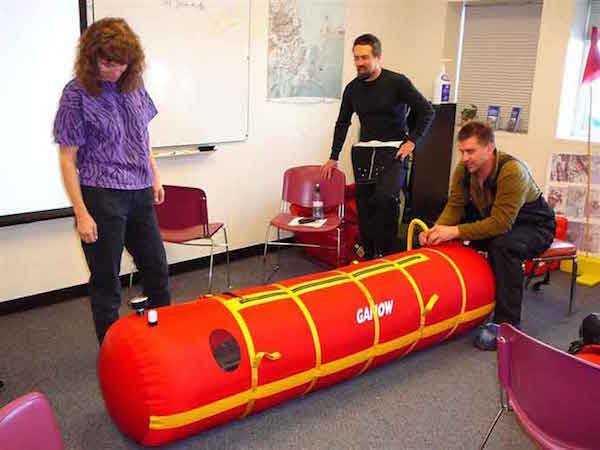 Using a GAMOW bag…. This was picture from google (http://www2.umaine.edu/USITASE/logbooks/archives07/Nov/NovGallery.html) Finally, we toured through Crary lab and the weather office. We plan to head back to the weather office for a weather balloon launch sometime soon 🙂
I have been taking a lot more photos and video along the way. I plan to edit a couple of videos, but I’m not sure if I will be able to share them through this blog due to the size of the files and the slower internet at McMurdo. I’m hoping I can find a way!
I’m looking forward to getting out in the field and sharing some more experiences with you!
Thanks,
Carol
Hello again! I’m back on the ice for another fun-filled, busy, and cold Antarctic field season. I arrived here late in the evening yesterday, 17 December, at 8:45 pm. I came with a couple new helpers to the Automatic Weather Station program: Carol Costanza, whom I work with at the Antarctic Meteorological Research Center, and Elin McIlhattan, a grad student in Atmospheric Science at UW-Madison and soon-to-be Master of Science! Carol will be posting some blog updates of her own, so look out for those! The three of us will be joining Lee Welhouse, who has been down here with Drew Slater from the National Snow and Ice Data Center at the University of Colorado. Drew left the ice earlier this week after helping Lee out for about a month and a half with field work. You can find his blog about his experiences here: http://penguinchasing.blogspot.com/ Thanks for your efforts, Drew! Your work is much appreciated, and your blog is fantastic!
Elin will be down here to assist Lee with fieldwork in West Antarctica, at the field camp at WAIS (West Antarctic Ice Sheet). There they will be installing two new stations, and completing maintenance to existing stations in the area.
Carol and I will be going to South Pole station shortly after the new year to do a complete instrument swap-out on two AWS, Henry and Nico. I’m really looking forward to getting to the true bottom of the Earth!
When the four of us are in McMurdo, we will be doing helicopter work when we can, to complete maintenance and checkups to our AWS in the McMurdo region. Some of these visits will simply be checkups, some will be instrument swap-outs, and at least one, Laurie II, will be a long-deserved station raise.
So, let’s switch gears a bit and summarize the flights from the United States to McMurdo, Antarctica. Carol, Elin and I met up in Dallas, TX to fly to Los Angeles, CA. From there, we flew across the Pacific Ocean on the 14-hour flight complete with complimentary meals, snacks, drinks, movies and TV shows. These flights went fairly smoothly, without too many hitches. We arrived in Sydney, Australia on Sunday, 14 December in the morning and had a 10-hour layover before our flight to Christchurch, New Zealand. During this layover, the three of us were able to get out of the airport and walk around downtown Sydney for a bit! It felt great to get some real fresh air and, for me, reacquaint myself with the area.
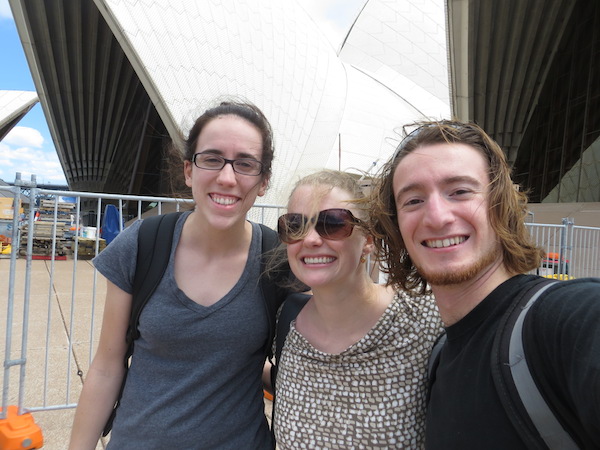 Carol, Elin and I at the Sydney Opera House. We walked around the Opera House, then to the amazing and expansive botanical gardens nearby. One can walk around the bay in the gardens and get another great view of the opera house…
 The Sydney Opera House I didn’t take many pictures of the gardens, but there are many beautiful flowers and a lot of birds.
Our flight to Christchurch was delayed an hour, which was disappointing because we were already scheduled to get in at a late 11:50 pm that night. We ended up getting into Christchurch at around 12:30 am on Monday 15 December, and didn’t get to our hotel until 2 am. It was long and exhausting travel, and a good night’s rest would have been great but we had to get to the Clothing Distribution Center (CDC) by 9:30 am that morning. That good night’s rest would have to wait.
The CDC went smoothly, and we had the rest of the afternoon to explore the roots of Christchurch’s nickname “The Garden City.”
 A personal gondola ride by a weeping Willow in the heart of Christchurch. 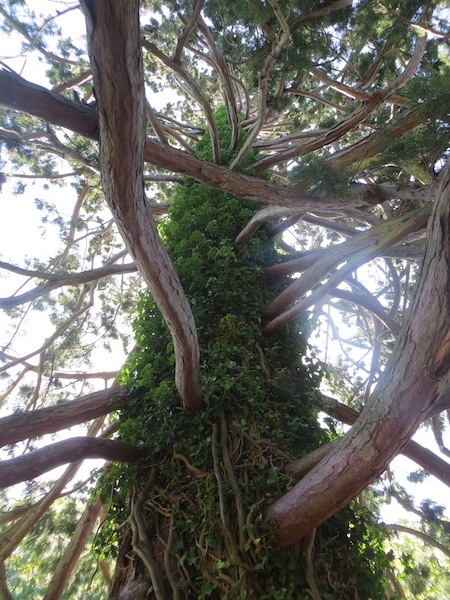 In the botanical gardens, there were many trees that tempted us to climb. The day was relaxing, and we were scheduled to fly to the ice on Tuesday, 16 December but we got weather delayed. There were low clouds and fog in McMurdo so landing would have been unsafe. We all were a little bummed because we had our expectations set on getting to Antarctica that day, but we also were happy to enjoy an extra day in Christchurch.
On 17 December, at 12:50 pm, we departed Christchurch on an LC-130, McMurdo-bound. Near the end of the flight I looked eastward out of the porthole by my seat and saw an expansive view of the terrain surrounding one of our weather stations: Cape Bird AWS.
 The northern tip of Ross Island. Cape bird AWS is located here on the coast, near the far left of the picture on rock. Part of Mount Erebus can be seen in the upper right corner. A short while later, we landed smoothly at Williams Field and stepped foot on Antarctica!
 Joey Snarski (former AMRC member, current Research Meteorologist at the Science Research Center in Charleston, South Carolina), Elin and Carol after we landed! I’m happy to be back on the ice, and I’m excited to relive the Antarctic experience!
Cheers!
Dave
So, the last week of this field season went and got itself in a big hurry, so much so that I’m no longer on the ice as I write this last post for our 2013-2014 field season.
There was a station that we had removed earlier in the season that we wanted to reinstall, Emma AWS. Originally, our last scheduled day to fly to this new site was Saturday 8 February. When Saturday came and went, we were put on the schedule for either the next Monday or Tuesday, whichever was a better weather day.
Unfortunately, the weather at Emma’s location was poor on Monday, but we did try flying to a different station, Vito AWS. As (bad) luck would have it, there were too many low clouds and fog at the site. We flew around, surveying the area, for about a half hour. The clouds were moving too quickly, so any opening we did see would soon close up before we could land. We never saw the station, and had we landed it would have been very difficult to see with the fog. We turned back to McMurdo.
Since we flew on Monday, that left Tuesday for us to snowmobile out to Windless Bight AWS to raise the station. There was a lot to do to prep for the trip: get the cargo ready and out to the snowmobiles by Scott Base, get some cargo supplies from town like a sled and survival bag, then load up everything. On top of this all, we had recently found out that Willie Field AWS, a station a few miles out on Pegasus Road, had some issues with the pressure readings that we needed to go check up on. It was feasible for us to visit Willie before Windless in the same day, and that’s what we did on Tuesday.
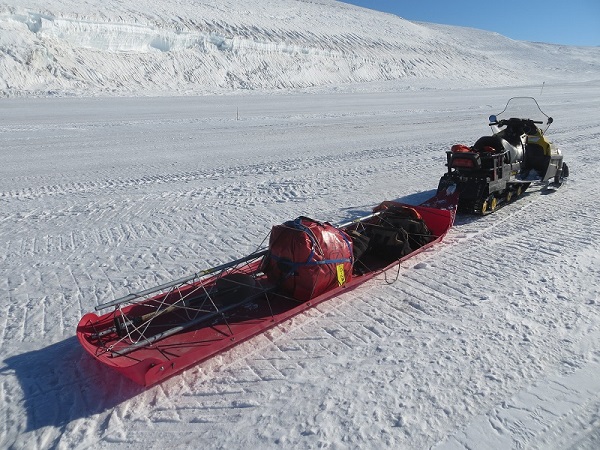 The sled Lee towed on the back of his snowmobile Of course, we weren’t able to fix everything on the first visit to Willie, so we had to go back on Wednesday. But before that we still had to do our work at Windless. We needed to raise the station, and that involved digging out the battery box, removing the instruments and upper-most tower section, then installing an additional tower section below the original. So the station went from about 7 feet high to 17 feet.
Driving out there was actually quite enjoyable. It was sunny, which I think makes it worlds better than driving when it’s cloudy because you can actually see the surface. Plus the scenery looks better.
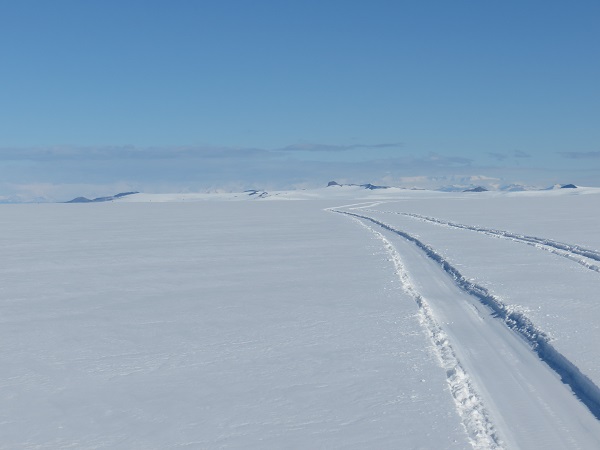 Looking back at town and our tracks when we arrived at Windless Bight AWS 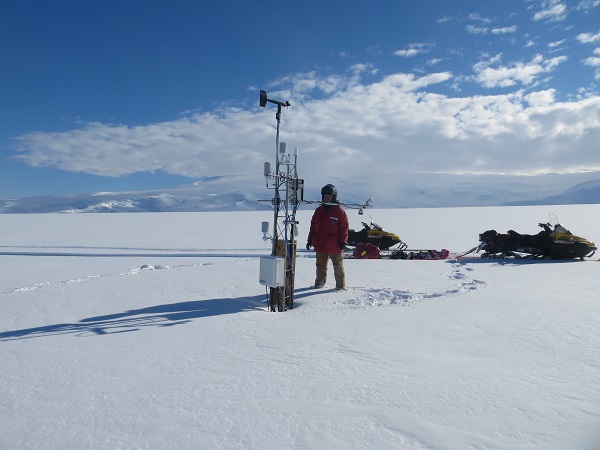 Lee scoping out the station. It definitely needed to be raised; there was at least 3 feet of snow accumulation in one year. Clouds started rolling in a couple hours into our work. It started innocently enough, with the sun being blocked for a few minutes at a time. Then the sky was completely overcast. Eventually, we noticed that land features on the horizon would go in and out of view, an indication that there was snow around. With about an hour of work left, the wind started picking up (at *Windless* Bight, of all places!) and flurries started falling.
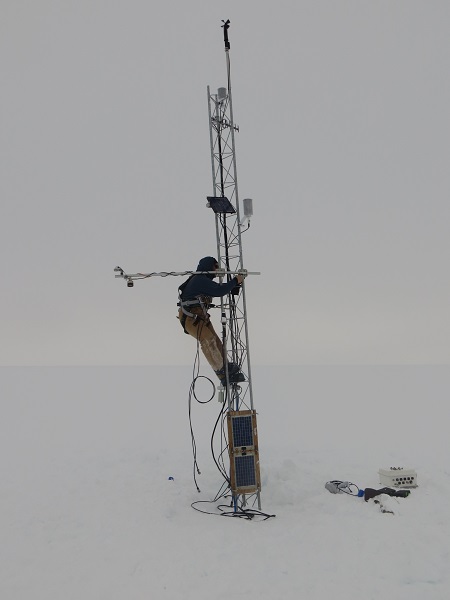 Lee attaching the instrument boom, with the skies completely overcast. We kept plugging away, and when we were just plugging the last of the instruments in, it started snowing. Lightly at first, but it became quite heavy, with a strong northeasterly wind (I believe). When Lee climbed up the tower to get measurements of the instruments, the tape measure was whipping and snapping in the wind, and it was very intense.
 The completed Windless Bight AWS. At this point, I just wanted to take this quick picture and get out of there so we could make it back to town. The best indication of the weather in this picture is the fact that you can’t make out the horizon at all. We radioed in to McMurdo to make sure the weather was good enough for us to travel in. They said it was good in McMurdo, but that it wasn’t going to get any better at Windless for a while. We are fairly certain that it was Condition 2 weather when we left (mostly due to visibility; the visibility was less than 1/4 mile). The thought crossed my mind whether we were going to have to open the survival bag and pitch a tent for the night. Since we could still see the flags marking the route back to McMurdo (thank goodness for flags!) we decided to give it a shot and head back.
For the first 5 or 10 miles of the ride, all we could see were the flags marking our route and a slate of white. It was an interesting feeling. The winds were blowing the snow across our sleds, and at times I could hardly see Lee as I followed him because of all the fresh snow he was whipping up. Eventually the sun shone through the clouds, though the snow still fell. As we got back on Pegasus Road, the snow stopped and there were only high clouds above. We even saw what appeared to be a snow devil on the horizon. That was sweet! We couldn’t get close enough to get a good picture of it though. When we parked our snowmos, we noticed some sun dogs!
 Sun dogs on either side of the sun So, when it seemed like the drive back to town would be stressful, it was actually almost as enjoyable as the ride out. One part that was tiring, though, was walking back to town from the snowmo depot. It took us a little over an hour, as we carried our bags and trekked up the hill with our cold weather gear on. This was made especially difficult because it was already at the end of a 12-hour day. It was long, but it was well worth the work.
Once we got the problems fixed with Willie, we had to pack all of our stuff into our orange shed for storage over the winter, as well as clean our lab and our dorm rooms. The work never seemed to end! But we got all of that done, and on 13 Feb, the day before we left, there were some incredible mirages, fata morgana I believe, on the horizon.
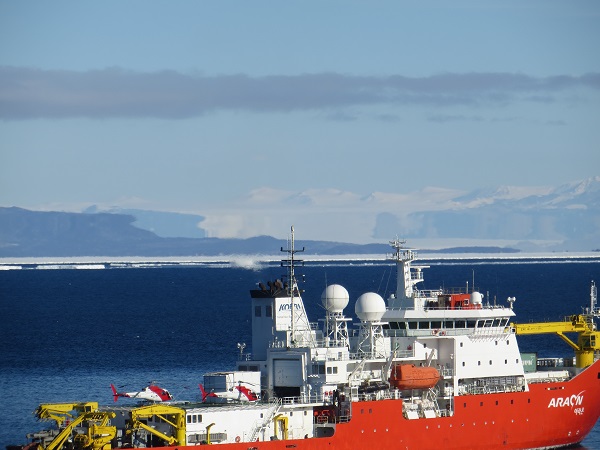 Fata morgana, evident above the ship on the horizon. The mountains definitely do not look like that! Our day of redeployment finally came on Friday 14 February, and of course Antarctica had one more trick for us. It snowed pretty much all day, but fortunately our plane was still able to take off.
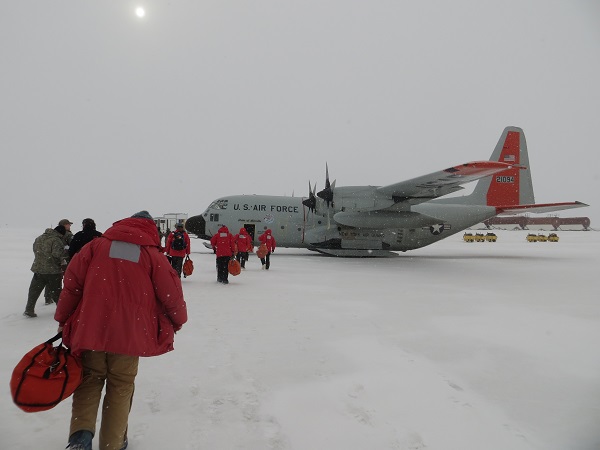 Lee, in the foreground, and everyone else boarding the LC-130 for the flight north to Christchurch, New Zealand. You can see the snow, but the plane was still able to take off with no difficulty. After about 7.5 hours, we landed in Christchurch! It was an overall smooth way to end a relatively successful field season, if you ask me.
I had a great time on the ice this year. It was good to spend more time in Antarctica. I got much more experience doing our weather station work, and as a result got many more cool experiences under my belt. And this year may forever be known, for me, as the year of the penguin. After not seeing any last year, I got my fair share of penguin sitings this year and then some!
With that, I’ll sign off on the blog for the 2013-2014 field season. It has been fun keeping you all updated on things, and I’ll be doing the same when I’m on the ice again next year!
Cheers!
Dave
At the end of my last blog post, I was updating you all on conditions from the storm as it was happening. It was very cool to be able to experience some intense Condition 2 weather in McMurdo. It’s amazing how quickly the visibility had dropped, and by how much. Here’s a picture from inside Crary, looking south toward the helo pad and the open water… But note that the open water is barely visible.
 Condition 2 from Crary It stayed like this for an hour or so, then the snow let up and the visibility improved. The storm was far from over, though. The wind was relentless, and continued even into the next day. Here are a few pictures of the waves caused by the storm.
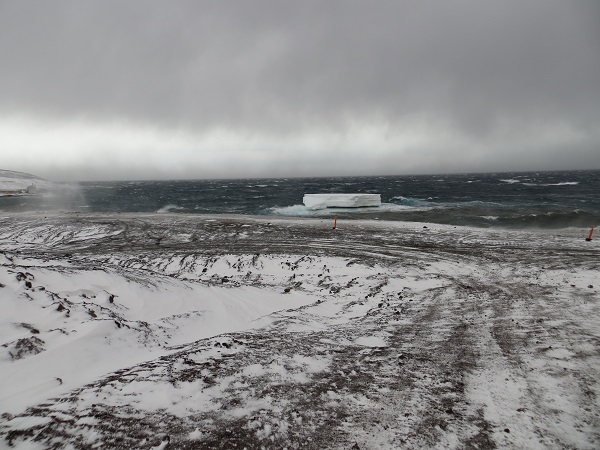 The snow stopped but the wind didn’t. An iceberg got lodged near the shore.  Hut Point, with the wind still whipping and the waves still crashing. Some snow accumulated on the point, but most of the white you see is ice formed from the spray from the waves. 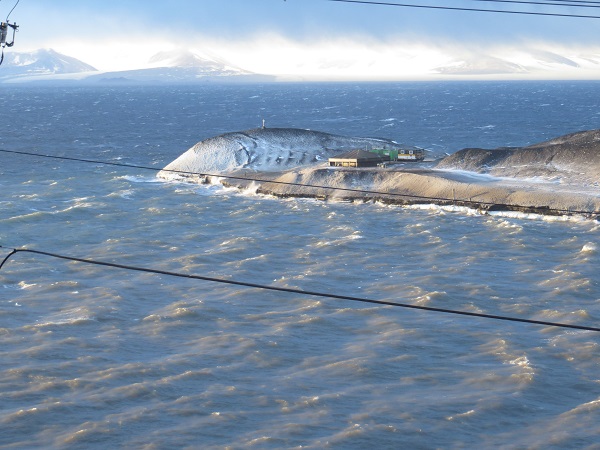 Later in the night, the sun poked through the clouds and highlighted the waves. Those last two pictures of Hut Point were missing one very important thing: the Vessel. Due to the unusually large expanse of open water around McMurdo, the waves were larger and more powerful than normal and caused the ship to jostle in the pier enough to destroy it. It wasn’t safe for the ship to stay there, so it had to leave town. This is unfortunate because not all of the cargo from McMurdo had been loaded onto the ship. This may have a negative impact on many groups, as people here are trying their best to get all the cargo shipped. It just goes to show how much of an impact the weather can have down here, from us not being able to land on the ice shelf, to winds generating powerful waves that cause the departure of the Vessel.
To end on a positive note, a few days ago an Adelie penguin wandered into town. It was amazing that it got so far into town, given all the hustle-bustle of the area. One would think it wouldn’t want to be so close to so many unusual objects and creatures (humans).
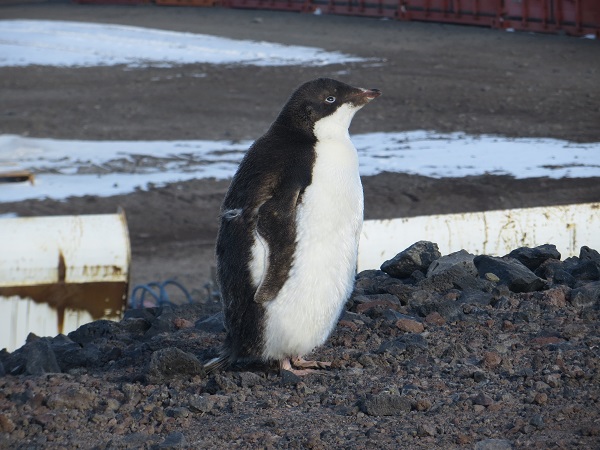 An Adelie in McMurdo! Cheers!
Dave
Back on 6 February, Lee and I finished our helo work for the season with our visit to Ferrell AWS. Earlier, we thought we had finished the helo work at Ferrell, but we’ve had difficulty with the freewave transmissions there. It seems as if that spot is a dead zone for VHF (very high frequency) transmissions, which are what freewave uses. When we landed, our helo pilot was trying to contact McMurdo via VHF radio but was unable to, even though he could see the repeater he was aiming for. This seems to be exactly what is happening to us with our freewave transmissions to White Island!
We want the Ferrell observations to be available realtime, so the purpose of our trip back was to reinstall the Argos antenna we had removed earlier this year. Lee, Jonathan Thom back in Madison, and I worked up a way to have both freewave and Argos transmissions at one station the day before we flew. It was all very last-minute, but fortunately it ended up working out.
 Ferrell AWS, with freewave and Argos transmissions installed (the white vertical pipe is the Argos antenna) One reason we were able to get out to Ferrell by helo on such short notice is because our fixed wing flights have been getting canceled due to weather. It’s tough when the weather here in McMurdo is good, but out on the ice shelf it’s too cloudy to land. We look out the window and think, how the heck aren’t we flying? But Antarctica is a big place.
The past couple days, we’ve been able to see (and feel) exactly why we’ve been canceled. There is a storm just north of us that is producing very heavy winds in our area. One night, the winds were whipping up the open sea water onshore. I don’t think the couple pictures I took did them justice.
 Big waves at McMurdo The winds have been too strong for planes to take off, and not just for the smaller, Twin Otter planes. Even off-continent, redeployment LC-130 flights are being canceled. Some of our friends in other groups were scheduled to leave the ice yesterday but were canceled due to the winds. Their departure date has been bumped back a few days, as flights that were supposed to leave today (yes, they got canceled too) were full of passengers with higher priority to depart.
Now we sit and wait for the weather to clear in McMurdo. This downtime does give us the opportunity to start packing away our gear for the winter. Hopefully Monday will bring clear skies and calm winds so we can service at least one more AWS by Otter.
Cheers
Dave
PHOTO UPDATE!
It’s started to snow in McMurdo…
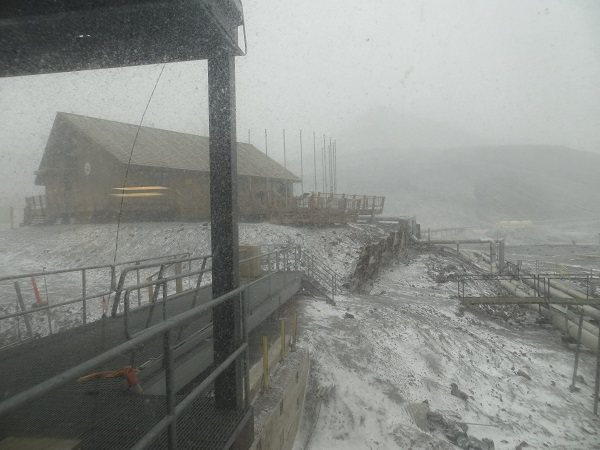 The view of the Chalet from Crary, just outside our lab. Definitely a no-fly day. An update on the weather, from the McMurdo intranet homepage:
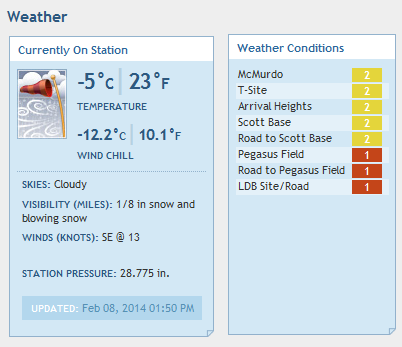 The weather in McMurdo and surrounding area. Condition 3 is good weather, Condition 2 is worse and Condition 1 is the worst. No outside travel is permitted in Condition 1 weather.
Lee and I took the Otter to Margaret AWS today, Monday 3 February. This station was installed in 2008 and had never been visited since. We knew that it was due to be raised, for two reasons:
One, with stations that we’ve installed on snow, it is almost always the case that there is snow accumulation, by precipitation and/or blow and drifting. The amount of accumulation depends on the location; some stations can get up to a few feet each year, and some don’t get any. If we know approximately how much snow an area gets a year, we can estimate how often we need to visit a station to raise it given the height of the instrumentation.
Two, the ADG (Acoustic Depth Gauge) instrument we have on Margaret recorded a height of about a half meter (1.5 feet) above the surface a few months ago. Many of our stations have this instrument, and it is a good way of knowing exactly how close the instruments are to getting buried. The ADG sends a pulse of sound waves towards the snow surface and measures the time it takes for that pulse to bounce back and reach the sensor. The longer the pulse takes, the higher the ADG is off the ground.
Knowing that we have to raise the station is half the battle. The tricky part is actually getting there (especially in Margaret’s case). It is by Roosevelt Island, on the Ross Ice Shelf about 500 km (310 miles) due east of McMurdo (a 2.5 hour flight). In this region, low cloud cover occurs often and in abundance (my previous blog post touched on this, when we visited the WISSARD fuel cache). I don’t know how many times we’ve been scheduled to go to Margaret this season and got canceled due to weather, flying somewhere else instead. We were pleasantly surprised to hear that Margaret was a go today. We flew across the shelf (a pretty boring flight, scenery-wise) and arrived at the station to be greeted by clear skies overhead.
 Margaret AWS, upon arrival The ADG is the instrument on the lowest “arm” that extends to the left at the bottom of the station. It was indeed low, as we expected, so we got to work right away on preparing everything to be raised.
We weren’t sure whether we should try to install a 7-foot or a 10-foot tower section to raise the station, so we brought both and made a game-time decision. We determined that the tower was tall enough to only warrant a 7-foot tower section. We felt that the 10-footer would have been too tall and that station may not have remained stable.
Unfortunately, the 7-foot tower section wouldn’t fit on top of Margaret. One, or both, of the tower sections was slightly skewed such that we could only fit 2 of the 3 poles of the tower section on at one time. After a few minutes struggling with it, Lee and I decided to give up on that and raise the instrumentation on Margaret’s current tower section. We probably won’t be able to wait 5 years until the next visit, but the instruments should be high enough for a few years’ time.
 Margaret AWS, after we raised the instruments Things didn’t go exactly as planned, but we were happy to get the instruments raised and have a successful trip to Margaret. We don’t take any flights to that region for granted!
An update on life in McMurdo:
The population has increased a bit in the past week, and ships have been in and out of the port. Now, the vessel is in town. For the next week, people in town are working tirelessly to unload the cargo from the vessel to supply McMurdo with food and other vitals for the next year. Once that’s all unloaded, cargo from McMurdo that needs to be shipped back to the US gets loaded on. This includes everything from science equipment to food waste. As you may imagine, it is a long operation. The weather is also starting to cool down here. Highs have mostly been in the low 20’s, and winds are starting to increase. This past Saturday night, it even snowed. It was fairly heavy for a bit too. It’s actually starting to feel like Antarctica again!
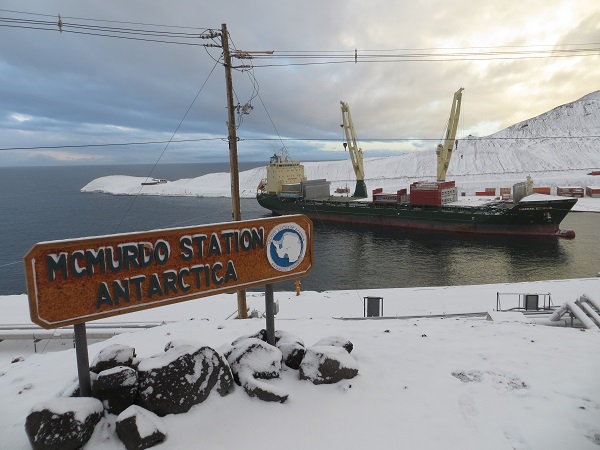 “McMurdo Station Antarctica,” the Vessel, and snow-capped Hut Point behind it. Cheers!
Dave
The Twin Otter work continued on Wednesday 29 January, as Lee and I were scheduled to reinstall Tom AWS, the one we had removed on 24 January. This AWS was to be moved to a new location. In our communication with the Otter pilots and flight coordinators, we had been referring to this new site as “New Tom AWS.” As Lee, Melissa, John and I were discussing this Tuesday night, Melissa came up with the idea to rename the station Emma AWS, after her and Tom’s 1-year-old daughter (Tom AWS was named after Melissa’s husband). We talked it over with the rest of the AWS crew back in Madison and determined that the new location of the station was far enough from the original to warrant a new station name, as it would probably show some unique weather to the original.
So on Wednesday morning, Lee and I shuttled out to Pegasus. We took off at about 9:30 am. Our first destination was the WISSARD fuel cache on the far side of the Ross Ice Shelf from McMurdo. The fuel here is meant for flights like ours: a long journey to and from McMurdo that couldn’t be made without refueling. This area of the Ross Ice Shelf is notorious for having bad flying weather, typically in the form of low clouds and fog. This is exactly how it was when we landed.
 The edge of the low clouds and fog outside WISSARD These clouds make it very difficult, if not impossible, to see the snow surface when landing. Instead of risking that dangerous landing, we flew past the edge of the cloud bank and landed in clear skies, then taxied to WISSARD for about 5 miles. That’s a long way to taxi, but it’s much safer than the alternative. When we arrived, there wasn’t much to see.
 Tanks of fuel at the WISSARD fuel cache Of course, there is usually more to see than initially meets the eye. As we were filling the plane up with fuel, I was taking in the foggy landscape. The sun was dulled by the clouds, and the sky and ground almost blended into each other. Looking away from the sun, the clouds were thinned out a bit, and I could see some of the sky. Looking exactly 180 degrees away from the sun, I saw the faintest of fogbows.
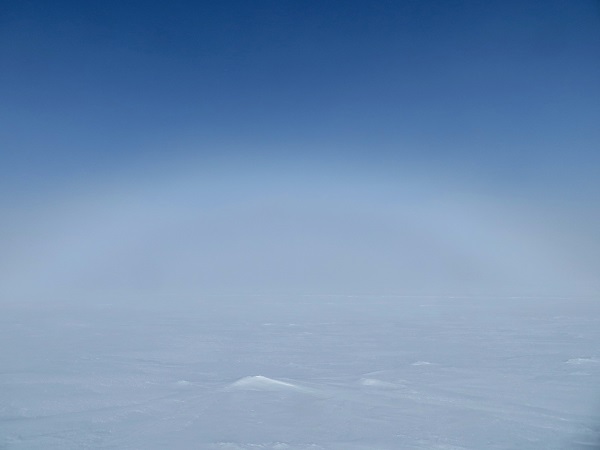 The very faint fogbow. I used a slight image enhancement to accentuate the feature, as it was difficult to capture on camera We departed the cache and headed for the coordinates where we thought Emma AWS was to be installed. As we were flying, Lee and I noticed that we had started going over the Transantarctic Mountain range, rather than staying over the ice shelf and flying along the mountains. We thought this was weird, but put this thought aside and enjoyed the scenery.
It was just as breathtaking as it was when we flew over them after we removed Tom AWS.
 The Transantarctic Mountains We flew along a glacier valley and reached an area that had some flat fields of snow, indicating a potential landing sight. The pilots did some investigating before landing the plane for good, though. Since this was a sight that had no records of being landed in before, it was important to determine the characteristics of the snow surface. As we circled the area several times, we noticed some spots that obviously had crevasses; these areas are way too dangerous to land on. There was an area that appeared to be crevasse-free, but the snow surface still needed to be characterized. To do this, the pilots dragged the skis of the Otter along the surface. This allowed them to get a feel for how the Otter reacted to the snow and see what the tracks looked like.
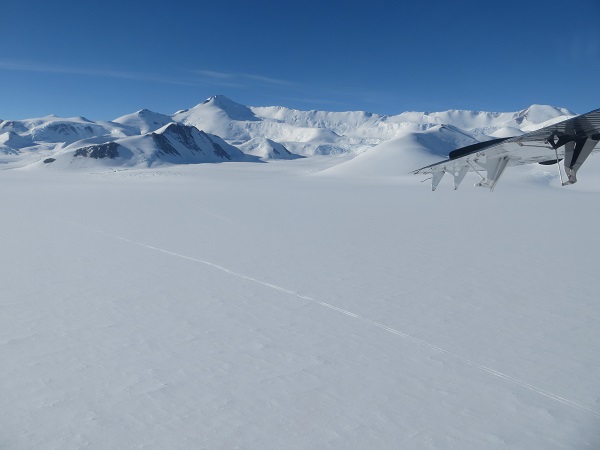 The open field of snow and the ski-marks from the Otter After a couple ski-drags and a few more fly-arounds, we all decided that this wasn’t a safe place to land. Though that field we were testing may have been crevasse-free, the snow was far too soft. On our last ski-drag test, we noticed the Otter start to sink too deep into the snow as we slowed down. It may have been very difficult to take off again had we come to a complete stop and did a couple hours of work.
We turned around and headed back out to the ice shelf. Fortunately, Lee and I were prepared to do some planned work at Sabrina. The wind propeller wasn’t functioning, so we were going to replace it.
Upon arrival at Sabrina, it was pretty obvious why the wind propeller wasn’t functioning.
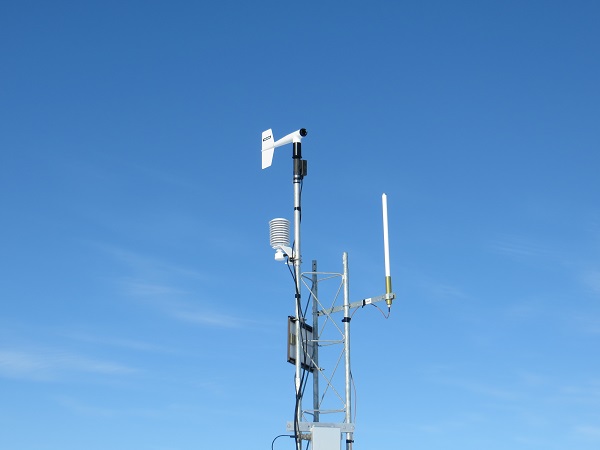 Sabrina AWS upon arrival. The wind propeller and nose cone had broken completely off. In addition to repairing the anemometer, we raised the lowest temperature sensor and replaced the data card.
 The updated Sabrina AWS We were on the ground at Sabrina for about an hour, and quickly got on the Otter and departed for the 3 hour flight back to McMurdo. It was a long, stressful day. It turned out that we had the coordinates for Emma AWS wrong by one degree latitude. It sounds insignificant, but it was the difference between landing on the sturdy, flat Ross Ice Shelf and attempting a landing on soft Transantarctic Mountain snow. There are two consolations to this mix-up: we were able to get to Sabrina AWS, and we still have just over a week’s time to get back out and install Emma AWS.
An Antarctic field season never ceases to surprise!
Cheers
Dave
|
|





































































